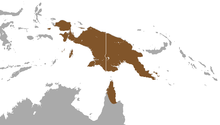| Long-nosed echymipera[1] | |
|---|---|
| Scientific classification | |
| Domain: | Eukaryota |
| Kingdom: | Animalia |
| Phylum: | Chordata |
| Class: | Mammalia |
| Infraclass: | Marsupialia |
| Order: | Peramelemorphia |
| Family: | Peramelidae |
| Genus: | Echymipera |
| Species: | E. rufescens
|
| Binomial name | |
| Echymipera rufescens | |

| |
| Long-nosed echymipera range | |
The long-nosed echymipera (Echymipera rufescens), or long-nosed spiny bandicoot, is a species of marsupial in the family Peramelidae. It is found in Australia, Indonesia, and Papua New Guinea. Its natural habitat is subtropical or tropical dry forests.[2]
Vernacular names
[edit]Vernacular names for E. rufescens in various Aru languages of the Aru Islands in far eastern Indonesia:[3]
- Ujir: koa
- Kola: koyi
- Dobel: ʔosi
- Batuley: koyi
- Manumbai: kagaran
- Goda-Goda: kawaran
- Lorang: kagwaran
- Koba: ngarukwabala
- West Tarangan: man
References
[edit]- ^ Groves, C.P. (2005). "Order Peramelemorphia". In Wilson, D.E.; Reeder, D.M (eds.). Mammal Species of the World: A Taxonomic and Geographic Reference (3rd ed.). Johns Hopkins University Press. p. 41. ISBN 978-0-8018-8221-0. OCLC 62265494.
- ^ a b Leary, T.; Wright, D.; Hamilton, S.; Singadan, R.; Menzies, J.; Bonaccorso, F.; Helgen, K.; Seri, L.; Allison, A.; Winter, J.; Aplin, K.; Dickman, C.; Salas, L. (2016). "Echymipera rufescens". IUCN Red List of Threatened Species. 2016: e.T7019A21966655. doi:10.2305/IUCN.UK.2016-2.RLTS.T7019A21966655.en. Retrieved 11 November 2021.
- ^ Schapper, Antoinette (2011). "Phalanger Facts: Notes on Blust's Marsupial Reconstructions". Oceanic Linguistics. 50 (1): 258–272. doi:10.1353/ol.2011.0004. S2CID 145482148.
External links
[edit]

Well, that’s interesting to know that Psilotum nudum are known as whisk ferns. Psilotum nudum is the commoner species of the two. While the P. flaccidum is a rare species and is found in the tropical islands. Both the species are usually epiphytic in habit and grow upon tree ferns. These species may also be terrestrial and grow in humus or in the crevices of the rocks.
View the detailed Guide of Psilotum nudum: Detailed Study Of Psilotum Nudum (Whisk Fern), Classification, Anatomy, Reproduction